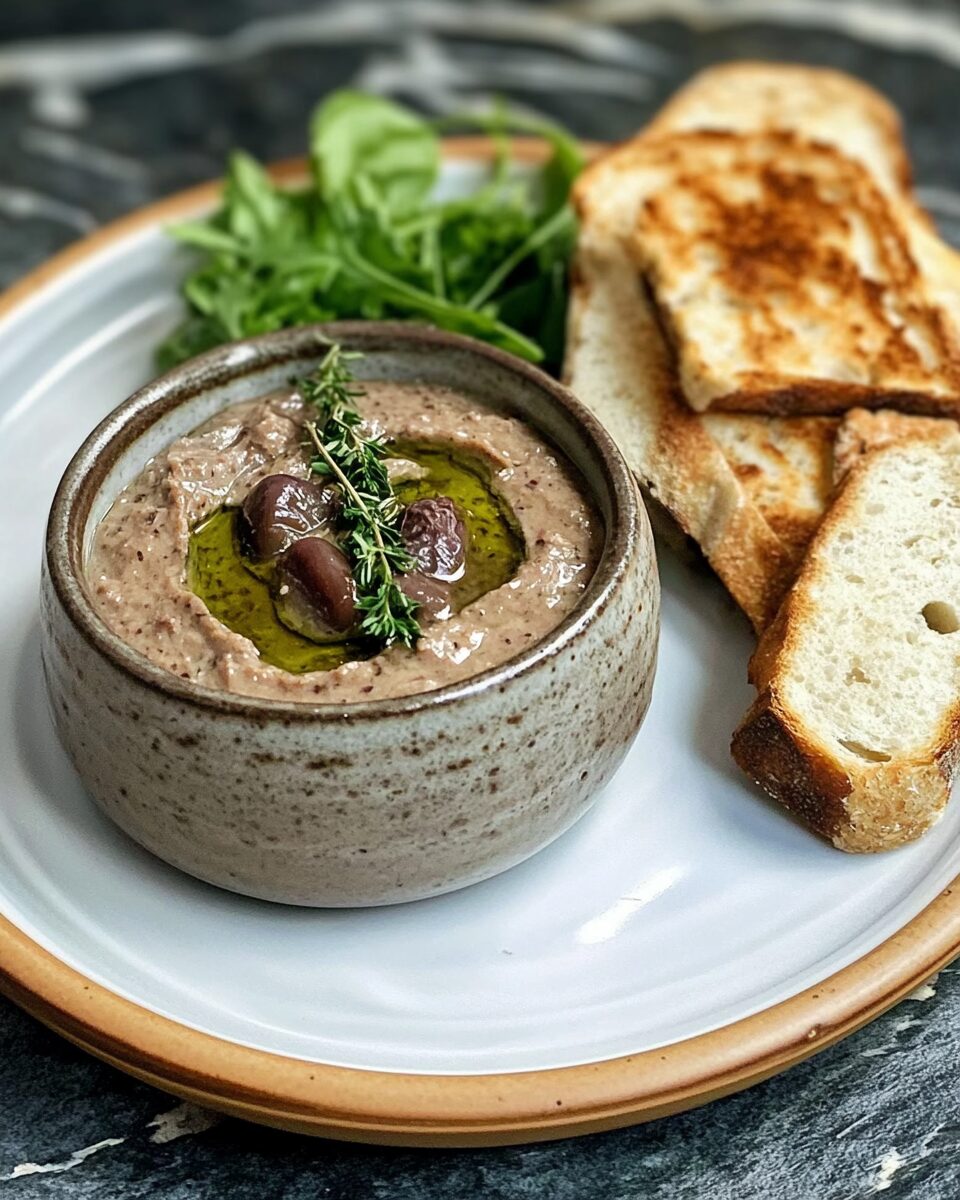Chicken liver pâté is a classic dish that combines simplicity with elegance. A delicacy that has been enjoyed for centuries, this creamy spread is often associated with French cuisine, though variations can be found in many cultures around the world. Despite its luxurious appearance and rich flavor, chicken liver pâté is surprisingly easy to prepare at home, making it an excellent choice for both special occasions and casual gatherings. In this article, we’ll explore the history of chicken liver pâté, the reasons behind its enduring popularity, the nutritional benefits of chicken livers, and some tips for serving this dish to elevate your culinary experience. Whether you’re a seasoned pâté enthusiast or trying it for the first time, this guide will offer you insights into the world of this delicious dish.
Full Recipe:
Ingredients:
- 1/2 lb (225g) chicken livers (trimmed and cleaned)
- 1 small onion (finely chopped)
- 2-3 garlic cloves (minced)
- 1/2 cup (115g) unsalted butter (divided)
- 2 tbsp olive oil
- 1/4 cup (60ml) brandy or cognac (optional)
- 1/4 cup (60ml) heavy cream
- 1/2 tsp salt (adjust to taste)
- 1/4 tsp black pepper
- 1/4 tsp ground nutmeg
- 1 tsp fresh thyme (or 1/2 tsp dried thyme)
- 1 tsp fresh parsley (chopped for garnish, optional)
Instructions:
1. Prepare the Chicken Livers:
- Clean the chicken livers by removing any connective tissue or greenish parts.
- Pat the livers dry with a paper towel.
2. Cook the Aromatics:
- Heat 2 tbsp of butter and 2 tbsp of olive oil in a skillet over medium heat.
- Add the chopped onion and cook until soft and translucent, about 5 minutes.
- Add minced garlic and cook for another minute until fragrant.
3. Cook the Chicken Livers:
- Add the chicken livers to the skillet and cook for 3-5 minutes per side until browned on the outside but still slightly pink on the inside (overcooking can make the pâté grainy).
- If using brandy, carefully pour it into the skillet and let it simmer for 1-2 minutes to burn off the alcohol.
4. Blend the Pâté:
- Transfer the cooked chicken livers, onions, and garlic into a food processor or blender.
- Add the remaining butter (softened), heavy cream, salt, pepper, nutmeg, and thyme.
- Blend until the mixture becomes smooth and creamy. Taste and adjust the seasoning if necessary.
5. Chill and Serve:
- Pour the pâté into ramekins or a small serving dish.
- For a smoother top, melt some butter and pour it over the pâté to seal it.
- Refrigerate for at least 2-3 hours, or until firm.
6. Garnish and Serve:
- Before serving, garnish with fresh parsley if desired.
- Serve the pâté with toasted bread, crackers, or sliced baguette.
Tips:
- You can add other flavorings like a splash of lemon juice or some shallots for variation.
- The pâté will last up to 4-5 days in the refrigerator if sealed properly.
The History and Origins of Pâté
Pâté has a long and fascinating history, with its origins tracing back to ancient times. In France, where pâté has become a beloved staple, it dates back to the Roman Empire. The word “pâté” itself comes from the Old French word for “paste,” referring to the soft, spreadable texture of the dish. While there are many different types of pâté, including those made from pork, duck, goose, and even vegetables, chicken liver pâté has carved out a special niche due to its affordable ingredients and delicious taste.
In French cuisine, pâté is often associated with fine dining and luxurious spreads, but it can be found in many forms across Europe. For instance, in Belgium and the Netherlands, liver pâté is commonly served on bread as a snack or appetizer. In Hungary, Jewish communities developed their own version of liver pâté called “chopped liver,” which is often made with onions and hard-boiled eggs for a unique flavor. In the UK, liver pâté became a popular dish during World War II when meat rationing made offal a more accessible option for families.
The beauty of chicken liver pâté lies in its versatility. It can be served as an hors d’oeuvre at an elegant dinner party or as a comforting snack at home. The balance between the richness of the liver and the creamy texture of butter or cream creates a smooth, luxurious taste that appeals to a wide variety of palates.
Why Chicken Liver Pâté Is So Popular
One of the main reasons for chicken liver pâté’s enduring popularity is its simplicity. With just a handful of ingredients, you can create a flavorful dish that rivals the offerings of high-end restaurants. While chicken livers may not be the most glamorous ingredient on their own, when combined with butter, onions, garlic, and a splash of brandy or cognac, they transform into a rich, velvety spread that can impress even the most discerning guests.
Another factor behind the appeal of chicken liver pâté is its versatility. You can serve it with various accompaniments, from toasted baguette slices to crisp crackers, and it pairs wonderfully with other appetizers such as cheese, olives, and pickles. It can also be enhanced with different herbs, spices, or even fruit preserves, making it a customizable dish that can suit any occasion or preference.
Moreover, chicken liver pâté is budget-friendly. Chicken livers are often inexpensive, making them an accessible option for home cooks who want to create a dish that feels luxurious without breaking the bank. Despite its affordability, the final product has a taste and texture that can rival much more expensive gourmet foods.
Nutritional Benefits of Chicken Livers
In addition to being delicious, chicken liver pâté is packed with nutrients. Chicken livers are an excellent source of essential vitamins and minerals, including vitamin A, vitamin B12, iron, and folate. These nutrients are important for various bodily functions, including maintaining healthy skin and eyes, supporting the immune system, and promoting red blood cell production.
One of the most significant health benefits of chicken liver is its high content of vitamin A. Vitamin A plays a crucial role in maintaining vision, particularly in low-light conditions, and it supports immune function and cell growth. Chicken livers are also rich in iron, which is essential for the formation of hemoglobin, the protein in red blood cells that carries oxygen throughout the body. This makes chicken liver pâté a great choice for individuals who need to increase their iron intake, such as those with anemia or pregnant women.
Vitamin B12, another nutrient found in abundance in chicken livers, is vital for nerve function and the production of DNA and red blood cells. It is particularly important for those who follow a diet that may lack animal products, as B12 is not readily available in plant-based foods.
While chicken liver pâté is a nutrient-dense food, it’s also worth noting that it is high in cholesterol and fat, especially if prepared with large amounts of butter or cream. As with many rich foods, moderation is key to enjoying its benefits without overindulging.
Tips for Serving Chicken Liver Pâté
One of the best aspects of chicken liver pâté is how easy it is to serve and present in a variety of ways. When preparing pâté at home, consider the following tips to enhance your presentation and flavor:
- Pair It with Bread or Crackers: Pâté is traditionally served with thin slices of toasted baguette or crisp crackers, providing a satisfying crunch that complements the smooth, creamy texture of the pâté. You can also serve it with whole-grain bread or crostini for a more rustic touch.
- Add a Sweet Element: The richness of chicken liver pâté pairs beautifully with something sweet. Serve it alongside fruit preserves, such as fig or apricot jam, or with caramelized onions for a delicious contrast of flavors. Some people also like to drizzle honey over the pâté to add a hint of sweetness.
- Garnish with Fresh Herbs: Fresh herbs like parsley, thyme, or chives can elevate the presentation of your pâté, adding both color and flavor. A sprig of thyme or a sprinkle of finely chopped parsley on top of the pâté can make the dish look as good as it tastes.
- Serve with Pickles or Cornichons: The tartness of pickles or cornichons can cut through the richness of the pâté, providing a refreshing contrast. This combination is a classic pairing in French cuisine and is often served alongside pâté on charcuterie boards.
- Use It as Part of a Charcuterie Board: Chicken liver pâté can be a great addition to a charcuterie board, alongside cheeses, cured meats, olives, nuts, and fresh fruit. The variety of flavors and textures will make for an impressive spread that can be served at any gathering.
- Portion It Into Individual Servings: For a more elegant presentation, consider serving chicken liver pâté in individual ramekins or small jars. This can make it easier for guests to spread and enjoy, while also giving your dish a professional touch.
Conclusion
Chicken liver pâté is a timeless dish that offers both elegance and simplicity. Its rich, creamy texture and deep flavor make it a versatile appetizer, perfect for both special occasions and casual get-togethers. With its roots in French cuisine, chicken liver pâté has become a global favorite, appreciated for its ease of preparation, affordability, and nutritional benefits.
Whether you’re serving it as part of a sophisticated charcuterie board or simply enjoying it on toast for a quick snack, chicken liver pâté is sure to impress. The balance of flavors, from the savory richness of the liver to the creamy butter and hint of brandy, creates a dish that is both indulgent and satisfying. Best of all, making it at home allows you to tailor the recipe to your taste, experimenting with different herbs, spices, and accompaniments.
As you savor each bite of this classic delicacy, you can appreciate not only the delicious flavors but also the history and tradition behind it. Chicken liver pâté, with its blend of luxury and simplicity, remains a beloved culinary staple that will continue to delight food lovers for generations to come.

